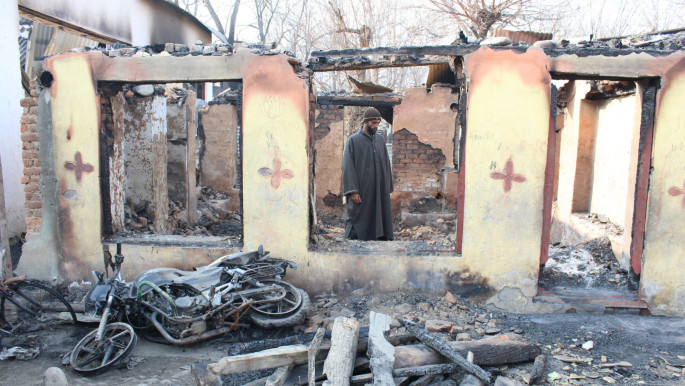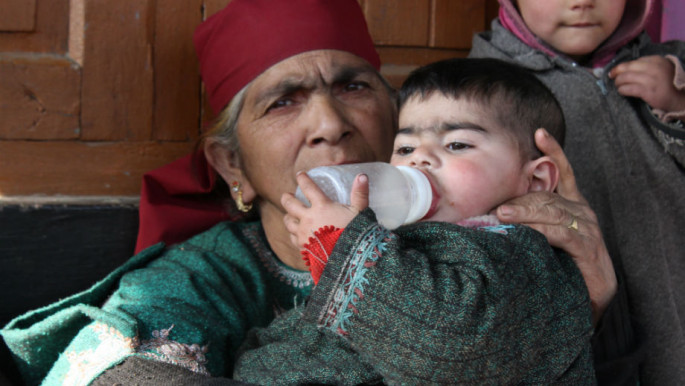India's search operations disrupt and destroy Kashmiri lives
Bhat's house was blown up on Deecember 19 by Indian troops after the discovery of two armed rebels led to Batmurran, a village nestled high in the hills of Southern Kashmir's Shopian district, becoming the scene of a fierce gunfight between Indian forces and armed rebels.
The pair had been detected during a Cordon and Search Operation in the area.
Nine other houses were either blown up or damaged during the ensuing battle.
Cordon and Search Operations (CASO) have again become a regular feature of counterinsurgency operations in Indian-administered Kashmir, a region that has witnessed armed rebellion against Indian rule since the late 1980s.
Through these operations, Indian forces lay siege to a target area, usually constituting one or several residential zones, and conduct door-to-door searches to kill armed rebels in gun battles.
Last year, according to data compiled by the Jammu Kashmir Coalition of Civil Society, an influential civil society group, at least 540 CASOs were conducted by Indian troops across Kashmir, and 500 of these in South Kashmir alone.
More than 200 armed rebels were killed - but they were not the only casualties.
 |
Cordon and Search operations (CASO) have again become a regular feature of counterinsurgency operations in Indian-administered Kashmir, a region that has witnessed armed rebellion against Indian rule since the late 1980s |  |
In Batmurran, a few houses away from where the rebels were hiding and later killed, Abdul Rashid Bhat's family sits in mourning on a cold, damp veranda shaded by walnut trees, an unusual sight in the harsh winters of Kashmir when people prefer to remain inside.
They are trying to escape the horrible memories of death when Rashid's daughter, Beauty Jan, was taken away in a flash.
Jan, who would have turned 20 on the day The New Arab visited her family's home, was killed when a bullet tore through the windows of their living room.
She left behind an 11-month-old baby and a broken family. "I am only living in the hope of raising this baby that my daughter left behind," Rashid told The New Arab, tears swelling up in his eyes.
 |
| Homes are frequently destroyed by Indian troops attempting to flush out militants during cordon-and-search operations in Kashmir [Saqib Mir] |
Loss of life and limb is a frequent feature of CASOs. The residents often clash with Indian forces in an attempt to break the siege imposed upon them, and also to give any rebels, who enjoy massive popularity in the region, a chance to escape.
In the same village where Beauty Jan was killed, 50-year-old Mohammad Ayoub Bhat also lost his life after being shot during clashes with Indian forces.
In their hunt for rebels, Indian troops frequently destroy private property. In Batmurran, the house belonging to Mohammad Yaqub Bhat, where the rebels had taken shelter, was turned into rubble by the Indian forces during a 24-hour gun battle.
"I had spent my entire life's savings to build this house," said Yaqub, while describing the intricacies of his now wrecked house. "The forces even blew up my cowshed, burning the cow inside it to death."
According to Yaqub and other villagers whose houses were also damaged, thedestruction of more than seven buildings could have been easily avoided.
However, Rajesh Yadaw, a spokesperson of the Central Reserve Police Force, an Indian paramilitary agency that assists the army during CASOs, recently told Al Jazeera that it was easier to blow up entire houses than engage in a drawn-out gunfight: "Why waste our time when a few IEDs can take care of the whole thing?"
The villagers also accused Indian forces of stealing their valuables, including gold and cash. "The forces hauled away with boxes of walnuts and even clothes," Ghulam Qadir Shah, a walnut-trader, told The New Arab. Many of the houses were vandalised and vehicles damaged beyond repair.
According to experts in international humanitarian and human-rights law, sieges enacted as punishment of civilians for actions taken by other members of their community, even those that are genuinely nefarious in nature, are a violation of the prohibition of collective punishment under customary International Humanitarian Law in international as well as non-international armed conflicts.
"Under Article 33 of the Fourth Geneva Convention and Article 47 of the Hague Convention of 1907, pillaging, imposing collective punishment and destruction of public and private property of protected persons is prohibited," a Kashmir-based human-rights lawyer wishing to remain anonymous for the fear of repercussions told The New Arab.
 |
| The prolonged gunfights that erupt as a result of cordon-and-search operations kill indiscriminately, robbing children of their parents [Saqib Mir] |
While the Indian military maintains that the rebels, hiding within the population, turn civilian areas into legitimate targets, the overwhelming and disproportionate use of force is still unexplained.
Besides, communication services including the internet are frequently suspended, sometimes for days, in areas under Cordon and Search Operations - causing massive disruption to day-to-day life.
"Due to the regular gags on internet services during these sieges, the students cannot access study materials and businesses also incur heavy losses," said Mir Zeeshan, a student from Pulwama district, which saw the highest number of CASOs in 2017.
According to Zeeshan, the communication blackout also accelerates the spread of disinformation and rumour-mongering - deeply unwanted in an already volatile region such as Kashmir.
Despite apparent public resentment against these operations, Indian authorities remain defiant, seeing them as a convenient method of counterinsurgency.





 Follow the Middle East's top stories in English at The New Arab on Google News
Follow the Middle East's top stories in English at The New Arab on Google News


